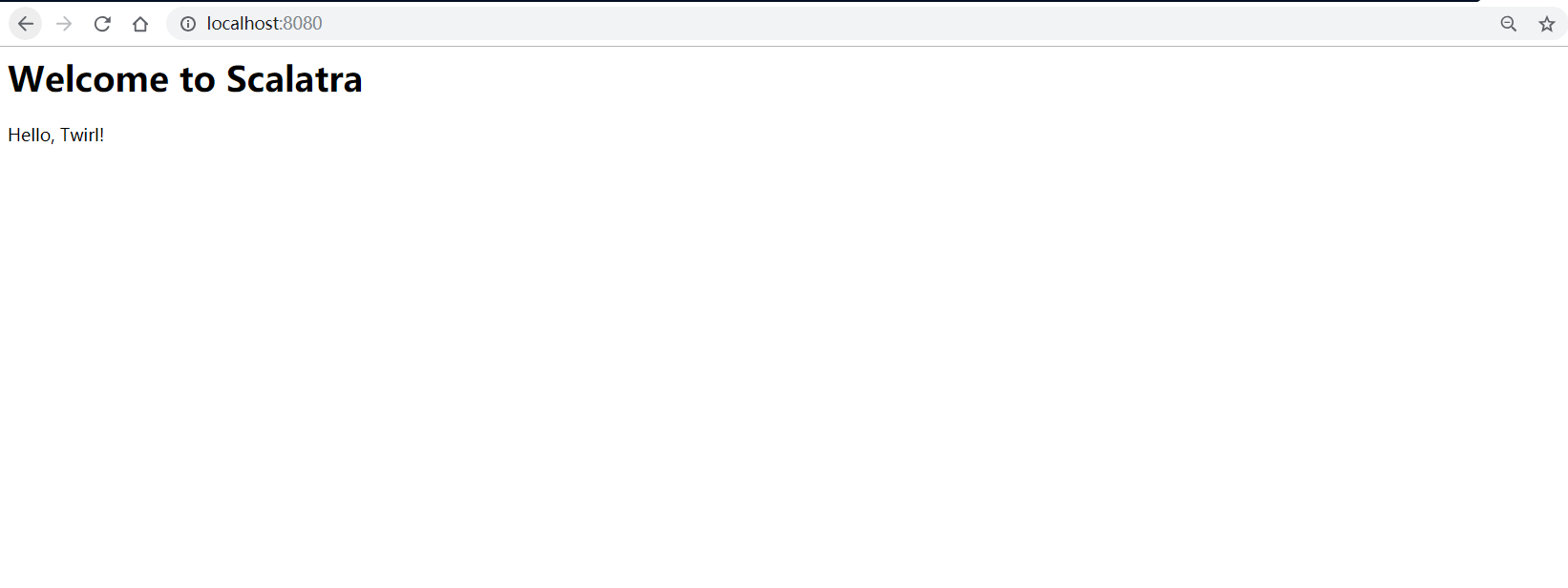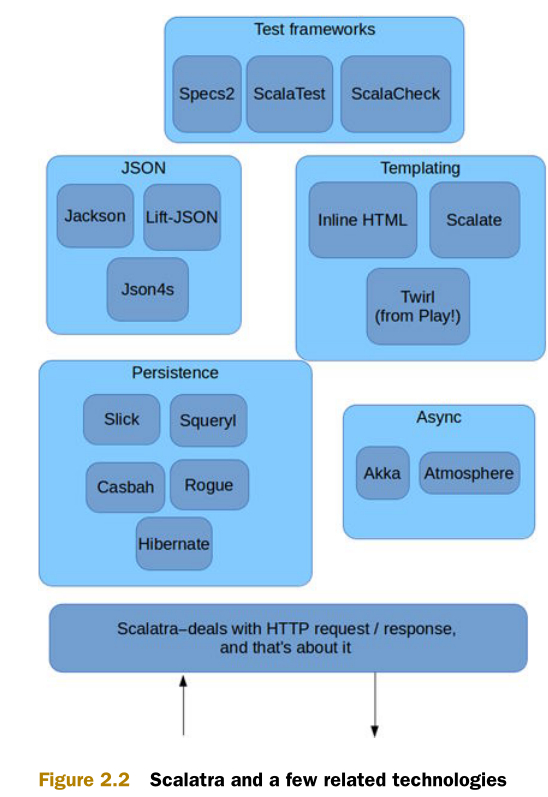前言 本系列文章是在阅读《Scalatray in Action》时的学习记录,会参杂个人见解,欢迎勘误抓虫。
标题创意来源于《python网络数据采集》”再端一碗Beautiful Soup” 下载模板 1 2 3 4 5 6 7 8 9 10 11 12 13 14 15 # 需要先安装giter8 $ g8 scalatra/scalatra-sbt.g8 # Starting sbt 0.13.13, Giter8 can be called from sbt’s "new" command as follows: # 当然你也可以直接使用sbt new来创建 $ sbt new scalatra/scalatra-sbt.g8 ... organization [com.example]: name [My Scalatra Web App]: version [0.1.0-SNAPSHOT]: servlet_name [MyScalatraServlet]: package [com.example.app]: scala_version [2.12.6]: sbt_version [1.2.1]: scalatra_version [2.6.4]: ...
这里会提示输入一些参数,直接一路回车就好了。
1 2 3 4 5 6 7 8 9 10 11 12 13 14 15 16 17 18 19 20 21 22 23 24 25 26 27 28 29 30 31 32 33 # 目录结构如下 $ tree . ├── README.md ├── build.sbt ├── project │ ├── build.properties │ └── plugins.sbt └── src ├── main │ ├── resources │ │ └── logback.xml │ ├── scala │ │ ├── ScalatraBootstrap.scala │ │ └── com │ │ └── example │ │ └── app │ │ └── MyScalatraServlet.scala │ ├── twirl │ │ ├── layouts │ │ │ └── default.scala.html │ │ └── views │ │ └── hello.scala.html │ └── webapp │ └── WEB-INF │ └── web.xml └── test └── scala └── com └── example └── app └── MyScalatraServletTests.scala
这里可以稍微解释下目录结构
build.sbt scala项目的配置文件
project 存放sbt版本信息和sbt插件信息
src 这之后的目录结构参考maven默认目录结构
我们可以从sbt控制台启动该web程序
1 2 3 4 $ sbt sbt:My Scalatra Web App> ~jetty:start
这个页面其实就是我们在Hello world项目 中的结果
Scalatra中到底有啥 Scalatra的核心只是一种路由HTTP请求的方式,以便在服务器上执行代码块
在这之外的所有其他功能都是通过外部工具包来实现的,下面这张图可以展示一个直观的联系。
▲ 图片来源:scalatra in action
通过giter8模板自动生成的scalatra项目会带有
scalatra-scalatest测试组件logback-classic日志记录组件jetty-webapp服务器
其中MyScalatraServlet.scala可以近似地看作为程序入口
1 2 3 4 5 6 7 8 9 10 11 package com.example.appimport org.scalatra._class MyScalatraServlet extends ScalatraServlet get("/" ) { views.html.hello() } }
很简单对吧,不过就是这个views.html.hello有点不太好理解。
我们回到之前的程序的目录结构图
1 2 3 4 5 6 7 8 9 10 11 12 13 14 15 16 17 18 19 20 21 22 23 24 25 26 27 28 29 ├── README.md ├── build.sbt ├── project │ ├── build.properties │ └── plugins.sbt └── src ├── main │ ├── resources │ │ └── logback.xml │ ├── scala │ │ ├── ScalatraBootstrap.scala │ │ └── com │ │ └── example │ │ └── app │ │ └── MyScalatraServlet.scala │ ├── twirl │ │ ├── layouts │ │ │ └── default.scala.html │ │ └── views │ │ └── hello.scala.html │ └── webapp │ └── WEB-INF │ └── web.xml └── test └── scala └── com └── example └── app └── MyScalatraServletTests.scala
这个目录结构其实和典型的maven标准目录结构 很像
稍有不同的地方在于
project/ sbt版本信息,sbt插件twirl/ play的web框架模板组件
需要简单说明下twirl的语法规则,参考官方文档
@ In Twirl @在twirl中作为一个特殊的标识符,标志着动态代码的开始,代码的结尾不需要显示的标识(因为会自动检测)
如:
Hello @customer.name!
Hello @(customer.firstName + customer.lastName)!
Hello @{val name = customer.firstName + customer.lastName; name}!
My email is bob@@example.com
模板参数
模板类似于函数,因此它需要参数,这些参数必须在模板文件的顶部声明:
1 2 3 4 5 6 7 @(customer: Customer, orders: List[Order]) //You can also use default values for parameters: @(title: String = "Home") //Or even several parameter groups: @(title: String)(body: Html)
循环
Note: 由于愚蠢的编辑器,需要手动保证{和for在同一行以确保动态代码能正确生效。
关键字和动态代码中间也不能有空格,要是写成@for (p <- products)也会报编译错误
更多例子可以参照上面给出的官方文档的链接。
回到之前的话题:
views.html.hello到底是什么东西?
如果你在 IDEA中打开项目(尚未编译运行过)的话,你会发现view会被标红,但是当你从sbt运行时,它就好了。
1 2 3 4 5 │ ├── twirl │ │ ├── layouts │ │ │ └── default.scala.html │ │ └── views │ │ └── hello.scala.html
这是因为在twirl框架中,views/Application/index.scala.html的模板文件会被编译成拥有apply方法的views.html.Application.index的类,在这个项目中,views/hello.scala.html生成的类view.html.hello就在target/scala-2.12/twirl/main/views/html/hello.template.scala
1 2 3 4 5 6 7 8 9 10 11 12 13 14 15 16 17 18 19 20 21 22 23 24 25 26 27 28 29 30 31 32 33 34 35 36 37 38 39 40 41 42 43 44 45 package views.htmlimport _root_.play.twirl.api.TwirlFeatureImports ._import _root_.play.twirl.api.TwirlHelperImports ._import _root_.play.twirl.api.Html import _root_.play.twirl.api.JavaScript import _root_.play.twirl.api.Txt import _root_.play.twirl.api.Xml object hello extends _root_ .play .twirl .api .BaseScalaTemplate [play.twirl.api.HtmlFormat .Appendable ,_root_.play.twirl.api.Format [play.twirl.api.HtmlFormat .Appendable ]](play.twirl.api.HtmlFormat ) with _root_ .play .twirl .api .Template0 [play.twirl.api.HtmlFormat .Appendable ] def apply/*1 .2*/ HtmlFormat .Appendable = { _display_ { { Seq [Any ](format.raw(""" """ ),_display_(layouts.html.default ("Scalatra: a tiny, Sinatra-like web framework for Scala" , "Welcome to Scalatra" ){_display_(Seq [Any ](format.raw(""" """ ),format.raw("""<p>Hello, Twirl!</p> """ )))})) } } } def render HtmlFormat .Appendable = apply() def f HtmlFormat .Appendable ) = () => apply() def ref this .type = this }
可以看到,代码中/*2.9*/位置又调用了layouts.html.default
1 2 3 4 5 6 7 8 9 10 @(title: String , headline: String )(body: Html ) <html> <head> <title>@title </title> </head> <body> <h1>@headline </h1> @body </body> </html>
生成的对应类target/scala-2.12/twirl/main/views/html/default.template.scala
1 2 3 4 5 6 7 8 9 10 11 12 13 14 15 16 17 18 19 20 21 22 23 24 25 26 27 28 29 30 31 32 33 34 35 36 37 38 39 40 41 42 43 44 45 46 47 48 49 50 51 package layouts.htmlimport _root_.play.twirl.api.TwirlFeatureImports ._import _root_.play.twirl.api.TwirlHelperImports ._import _root_.play.twirl.api.Html import _root_.play.twirl.api.JavaScript import _root_.play.twirl.api.Txt import _root_.play.twirl.api.Xml object default extends _root_ .play .twirl .api .BaseScalaTemplate [play.twirl.api.HtmlFormat .Appendable ,_root_.play.twirl.api.Format [play.twirl.api.HtmlFormat .Appendable ]](play.twirl.api.HtmlFormat ) with _root_ .play .twirl .api .Template3 [String ,String ,Html ,play.twirl.api.HtmlFormat .Appendable ] def apply/*1 .2*/ String , headline: String )(body: Html ):play.twirl.api.HtmlFormat .Appendable = { _display_ { { Seq [Any ](format.raw(""" """ ),format.raw("""<html> <head> <title>""" ),_display_(title),format.raw("""</title> </head> <body> <h1>""" ),_display_(headline),format.raw("""</h1> """ ),_display_(body),format.raw(""" """ ),format.raw("""</body> </html>""" )) } } } def render String ,headline:String ,body:Html ): play.twirl.api.HtmlFormat .Appendable = apply(title,headline)(body) def f String ,String ) => (Html ) => play.twirl.api.HtmlFormat .Appendable ) = (title,headline) => (body) => apply(title,headline)(body) def ref this .type = this }
这个又长又乱的代码就不再仔细看了,有兴趣可以慢慢研究
现在我们可以大致的标一下程序运行的过程,可能不太严谨,只是为了有一个直观的认识。
ScalatraBootstrap初始化,调用MyScalatraServletMyScalatraServlet处理路由请求,对根目录下的请求转发到views.html.hello处理views.html.hello传递两个参数,作为title和headline,同时传入一个行内html代码块default.template.scala生成具体的html代码
如此一来,我们解决了第一章的大部分问题(除了启动流程还是有些模糊)
其实上面这一大坨等效于
1 2 3 4 5 6 7 8 9 10 11 12 13 14 15 16 17 18 19 20 package com.example.appimport org.scalatra._class MyScalatraServlet extends ScalatraServlet get("/" ) { <html> <head> <title>Scalatra : a tiny, Sinatra -like web framework for Scala </title> </head> <body> <h1>Welcome to Scalatra </h1> <p>Hello , Twirl !</p> </body> </html> } }
可见某些时候框架会帮助 再咬上一口scalatra 上面这种写法虽然更加简单,但是也引入一个问题——我们无法对数据进行抽象,说到底,还是需要定义一个数据结构。
为了简单起见,我们可以直接在MyScalatraServlet.scala中添加代码(为什么加这样的数据类型当然是参照scala in action 偷懒呀)
1 2 3 4 5 6 7 8 9 10 11 12 13 14 15 16 17 18 19 20 21 22 23 24 25 26 case class Page (slug:String , title:String , summary:String , body: String )object PageDao val page1 = Page ("bacon-ipsum" , "Bacon ipsum dolor sit amet hamburger" , """Shankle pancetta turkey ullamco exercitation laborum ut officia corned beef voluptate.""" , """Fugiat mollit, spare ribs pork belly flank voluptate ground round do sunt laboris jowl. Meatloaf excepteur hamburger pork chop fatback drumstick frankfurter pork aliqua. Pork belly meatball meatloaf labore. Exercitation commodo nisi shank, beef drumstick duis. Venison eu shankle sunt commodo short loin dolore chicken prosciutto beef swine elit quis beef ribs. Short ribs enim shankle ribeye andouille bresaola corned beef jowl ut beef.Tempor do boudin, pariatur nisi biltong id elit dolore non sunt proident sed. Boudin consectetur jowl ut dolor sunt consequat tempor pork chop capicola pastrami mollit short loin.""" ) val page2 = Page ("veggie-ipsum" , "Arugula prairie turnip desert raisin sierra leone" , """Veggies sunt bona vobis, proinde vos postulo esse magis napa cabbage beetroot dandelion radicchio.""" , """Brussels sprout mustard salad jícama grape nori chickpea dulse tatsoi. Maize broccoli rabe collard greens jícama wattle seed nori garbanzo epazote coriander mustard.""" ) val pages = List (page1, page2) }
关于case calss 可以参阅官方文档 和另一篇文档
object的话目前需要知道它是单例 就行了
Note: 实际使用过程中,当然不推荐把数据直接写到代码里,最好是存放到数据库中。
现在我们已经”存储“了一些页面,现在的问题是如何访问这些页面,还记得之前说的scalatra的核心是什么吗?
At its core, Scalatra is nothing more than a way of routing HTTP requests in order to exe-
继续添加以下代码
1 2 3 4 5 6 7 8 9 10 11 12 13 get("/pages/:slug" ) { contentType = "text/html" PageDao .pages find (_.slug == params("slug" )) match { case Some (page) => page.title case None => halt(404 , "not found" ) } }
关于scalatra的路由语法可以参考官方文档
简单来说http://localhost:8080/pages/anything-at-all 会触发这段代码,params("slug")的值为anything-at-all
这里发生了很多事情。路由的操作使用find方法scala的List类。在本例中它被用作通配符模式。
pagedao.pages列表中的每个页面对象实例都迭代发送到match函数,如果页的slug与参数(“slug”)匹配,则匹配块将生成那页的标题。如果找不到匹配页,则match块调用halt并返回HTTP 404状态代码。
听起来很复杂吗,不如直接运行看看吧。
完整代码如下:
// MyScalatraServlet.scala
package com.example.app
import org.scalatra._
class MyScalatraServlet extends ScalatraServlet {
get("/pages/:slug") {
contentType = "text/html"
PageDao.pages find (_.slug == params("slug")) match {
case Some(page) => page.title
case None => halt(404, "not found")
}
}
}
case class Page(slug:String, title:String, summary:String, body: String)
object PageDao {
val page1 = Page("bacon-ipsum",
"Bacon ipsum dolor sit amet hamburger",
"""Shankle pancetta turkey ullamco exercitation laborum ut
officia corned beef voluptate.""",
"""Fugiat mollit, spare ribs pork belly flank voluptate ground
round do sunt laboris jowl. Meatloaf excepteur hamburger pork
chop fatback drumstick frankfurter pork aliqua.
Pork belly meatball meatloaf labore. Exercitation commodo nisi
shank, beef drumstick duis. Venison eu shankle sunt commodo short
loin dolore chicken prosciutto beef swine elit quis beef ribs.
Short ribs enim shankle ribeye andouille bresaola corned beef
jowl ut beef.Tempor do boudin, pariatur nisi biltong id elit
dolore non sunt proident sed. Boudin consectetur jowl ut dolor
sunt consequat tempor pork chop capicola pastrami mollit short
loin.""")
val page2 = Page("veggie-ipsum",
"Arugula prairie turnip desert raisin sierra leone",
"""Veggies sunt bona vobis, proinde vos postulo esse magis napa
cabbage beetroot dandelion radicchio.""",
"""Brussels sprout mustard salad jícama grape nori chickpea
dulse tatsoi. Maize broccoli rabe collard greens jícama wattle
seed nori garbanzo epazote coriander mustard.""")
val pages = List(page1, page2)
}
下面是运行结果
小结 我们简单调试了scalatra,但我们的问题也越来越多
如何单独部署写好的WEB项目
如何调整布局
Scalatra的各种组件有哪些适用范围
如何测试


